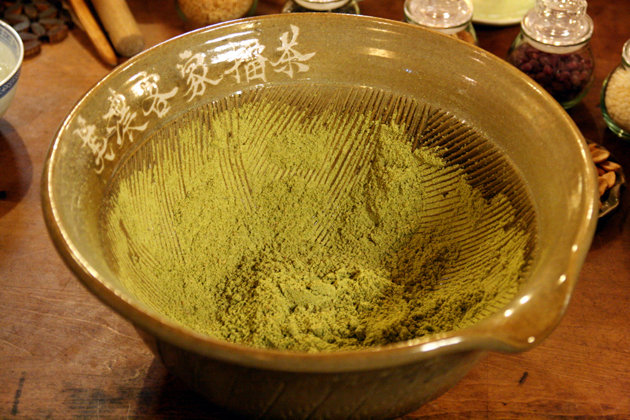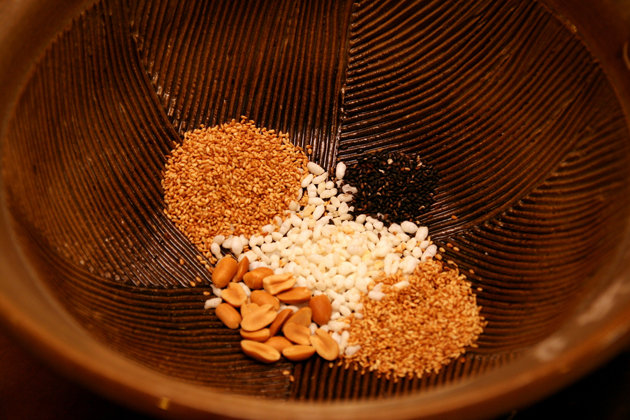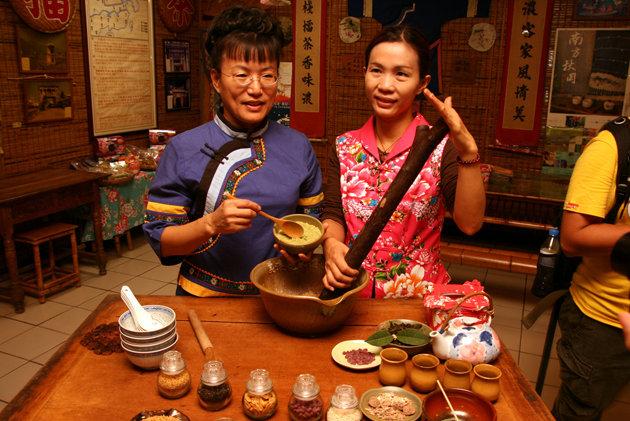
Taiwan’s Hakka Lei Cha – A Sweet Version
By Catherine Ling - Tuesday, Nov 27, 2012
In the predominantly Hakka enclave of Meinong, just outside Kaohsiung in Taiwan, the residents enjoy a good bowl of “Lei Cha” or Thunder Tea, and often serve it to visiting guests along with some “gui hua cha” or osmanthus tea as starters. But their Lei Cha is very different from the savoury minty bowl of soup that we know here in Singapore. Theirs is sweet – something more akin to the sesame paste dessert than a multi-vegetable rice dish.
It’s been said the name “lei” doesn’t really refer to thunder but the act of the grinding of ingredients (both sound the same in Chinese). Then again the low rumbling noise created by the milling can make one think of thunder anyway.
The Hakka ladies make the grinding look really easy, and their method of grinding does make nifty use of physics (the upper end of the pestle is the fixed fulcrum, and the bottom is the only part that rotates). But try it for a short while, and you’ll understand why most of these women don’t have flabby arms.
The key ingredients are roasted peanuts, popped rice, and sesame seeds (more white than black because the black variety is more heaty). Each ingredient is chosen for a certain function and for balance. Peanuts provide energy, the white sesame seeds are good for hormone production and the black sesame seeds benefit the kidneys, nervous system and reproductive system. These ingredients form the base and are milled using the wooden mortar and pestle. The fragrance that’s released is also incredibly appetising.

Then the women add powdered sugar that’s infused with sencha or green tea. Sugar used to be a status symbol among the Hakka as only the rich could afford to have sugar in their household.

The green tea’s astringent and cooling properties balance the heaty elements of the nuts and seeds. The tea also helps with the body’s metabolism, so it is very popular with the rich who tend to live a more sedentary life and have a richer diet.

The tea is also enjoyed by the poorer folk who have developed very thrifty habits. They would keep their used tea leaves and dry them out for lei cha.
This is the end product. You know the mixture has been milled enough when the powder starts clumping a little, as the oils are released from the peanuts and sesame seeds. The Hakka women will add some hot water to this sweet tea powder to make a thick liquid. You first drink this unadorned to savour the original flavours of the tea. For later servings, you can scatter some popped rice or candied red beans (which purportedly help nourish blood) for variations in taste.
If you are ever in Kaohsiung, it’s worthwhile popping into one of the lei cha shops in Meinong to have a taste of this sencha-peanut-sesame paste concoction. It’s not only different from the lei cha we know, but you also get a chance to try grinding the ingredients yourself.


